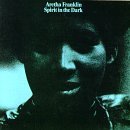Music |
Spirit in the Dark
Aretha Franklin
By
Published: Jan 01, 2005
Category:
Soul
There’s a lot to be said for loud music; raw energy is the foundation of rock.
But there’s also a lot to be said for quiet music, like Chopin, that you have to lean in to hear.
We don’t think of Aretha Franklin as a quiet performer, but that’s because we think of her only as a singer. We savor her soulful shouting. We’re dazzled by five-octave runs from the guttural to the soprano. And we bow to her when she demands r-e-s-p-e-c-t.
That high-octane Aretha can be found on "Spirit in the Dark," a neglected masterpiece from 1970. But so can something subtler and more compelling — her astonishing piano playing, which you can hear on ten of the album’s dozen songs.
Why don’t we think of Aretha as a double threat? In large part, because we really don’t know much about her at all. Oh, we know about the gospel childhood in her father’s church, her first recordings at 14, her ten Top Ten hits in a 18-month span between 1967 and late 1968. That she sang at Martin Luther King’s funeral and at Bill Clinton’s Inaugural gala. That she’s won something like 15 Grammys — and was the first female inductee into the Rock and Roll Hall of Fame. [To buy "Spirit in the Dark" from Amazon, click here.]
But about her personal life, her music-making — almost nothing. Ms. Franklin is very private. Interviews are rare, insights rarer. And so it is with difficulty that journalists pieced together a portrait of a woman who was on intimate terms with despair. In the ’60s, a friend says, she was so depressed that he was amazed she could sing at all. Her first mentor, John Hammond, said she had "terrible luck" with men.
We have belatedly learned that, in the late 1960s, she took ten months off from work for "personal reasons" — mostly a divorce from her husband and manager Ted White. And that she had a fourth son with a new lover in 1970. In between, she recorded "Spirit in the Dark" — writing five of the songs (more than she has on any other CD) and getting seven of the tracks down in a single day.
That long day of accomplishment gives "Spirit in the Dark" a rare consistency. The songs come in two flavors — goodbyes to an old love, jubilation over a new one. There’s no rancor (even on B.B. King’s "The Thrill Is Gone," she wishes her old lover well), just acceptance. That’s a "new" Aretha, freed of the super-highs and dark bottoms of earlier releases.
And freed, too, to show off her talent as a pianist. Her touch is so light and subtle that you need to pay close attention — maybe even wear headphones — to grasp just how good she is. There are great musicians backing her up, but it’s the piano that grounds the songs and connects the gospel and blues with the secular.
Why don’t we all own this CD? Because, although it’s among Aretha’s two or three best releases, it never topped #25 on the charts. Why? No singles, no hits. But that was 1970; now we know better, now we care about the arc of a dozen songs.
And in these dozen songs, we get a primer. This is what soul singing is all about. This is what blues piano is all about. Fabulous to have them both in a single record, produced by a remarkable performer.


